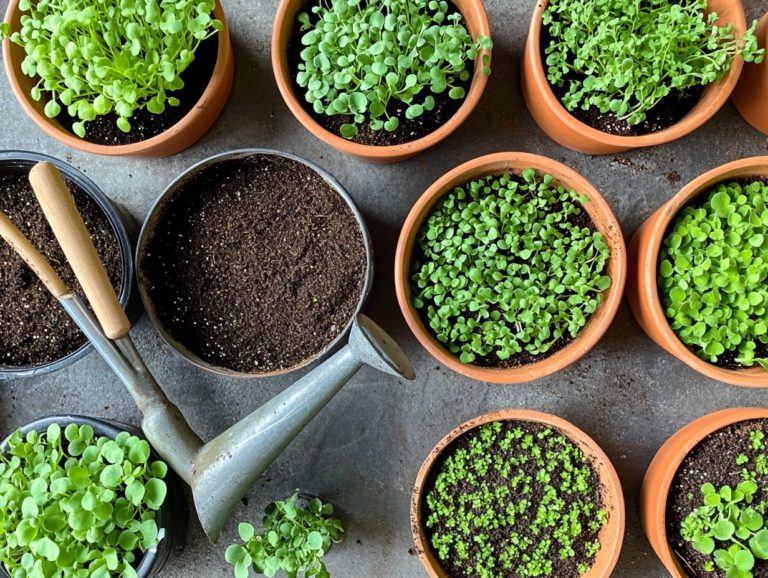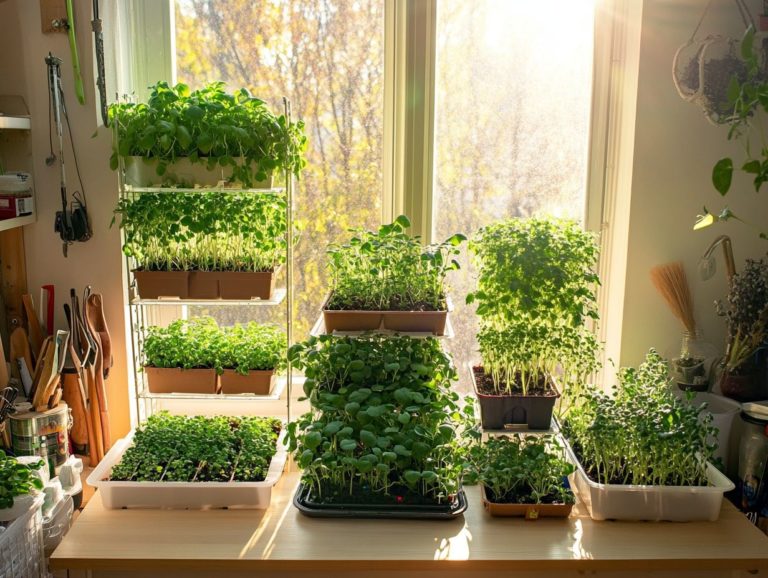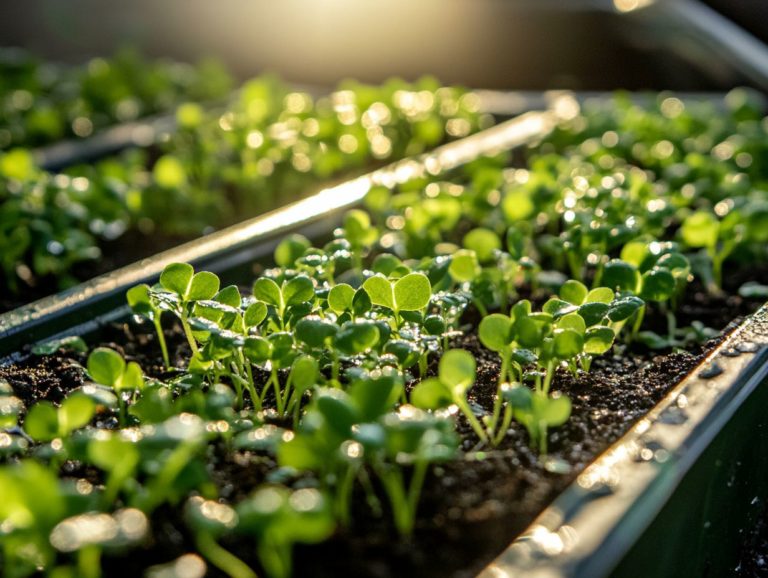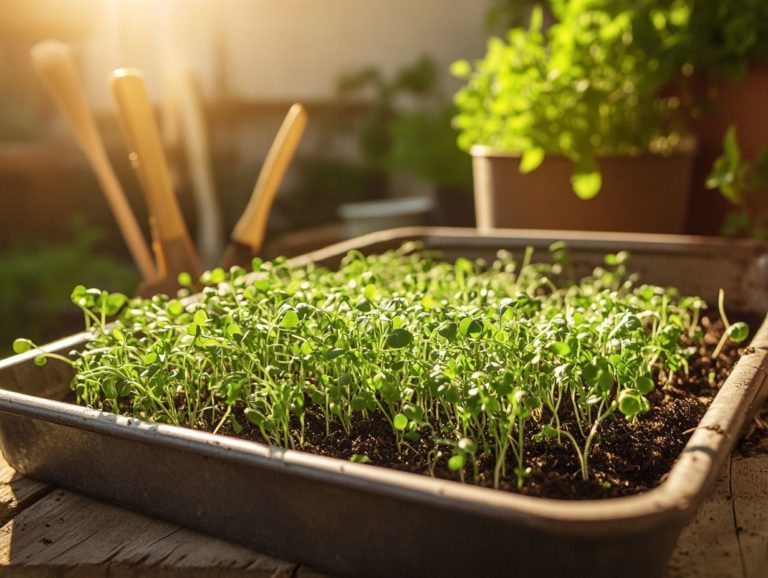Essential Tools for Microgreen Growing Success
Microgreens are tiny plants packed with nutrients. They can elevate your cooking and boost your health.
This guide explores microgreens. Discover what they are and the benefits they bring.
You’ll learn how to choose the right tools and seeds. Create an optimal growing space and tackle common challenges.
With our step-by-step guide, you ll soon thrive in growing vibrant, flavorful microgreens indoors!
Contents
Key Takeaways:
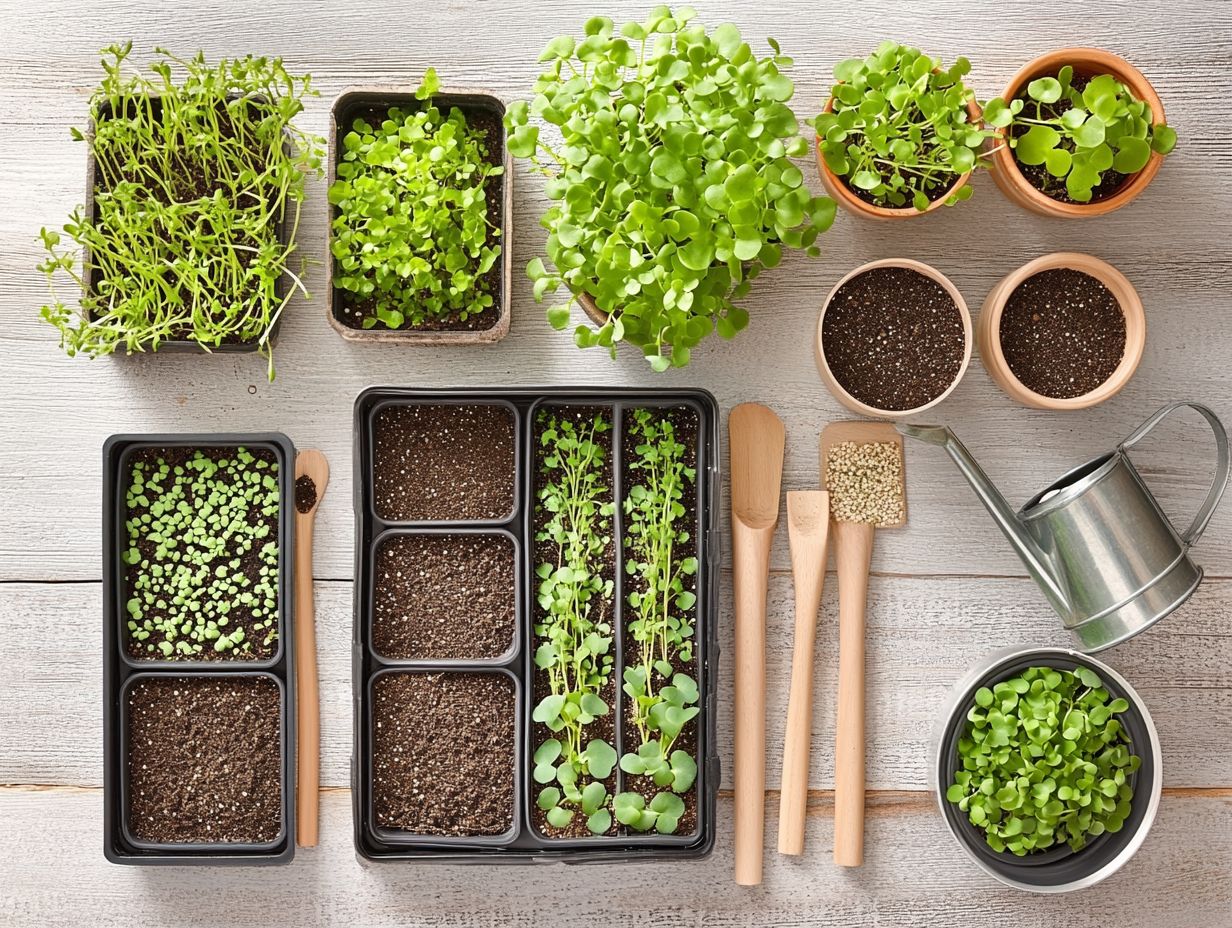
What are Microgreens?
Microgreens are young, edible plants harvested after the first true leaves grow. They are colorful and flavorful, making them a great addition to any meal.
Varieties like broccoli, Red Russian Kale, and Red Acre Cabbage not only catch the eye with their vibrant colors but also deliver substantial health benefits. It s no wonder they ve become a favored choice for home gardeners and cooking lovers alike, eager to elevate their dishes with a burst of flavor and nutrition.
Definition and Benefits
Microgreens are the young seedlings of edible vegetables, herbs, and plants. They showcase vibrant colors and deliver concentrated flavors that can elevate any dish.
These tiny powerhouses are packed with impressive nutritional benefits, making them an essential addition to your health-conscious diet, especially when grown in water without soil. Rich in vitamins A, C, E, and K, along with essential minerals like calcium and magnesium, microgreens can boost your immunity and enhance your overall vitality.
Incorporating microgreens into your meals elevates flavor profiles without piling on extra calories, making them a favorite among cooking enthusiasts. If you’re passionate about organic gardening, growing your own microgreens is a sustainable and rewarding way to have fresh produce at your fingertips. This not only contributes to your personal well-being but also supports a healthier planet.
Choosing the Right Tools for Microgreen Growing
Choosing the right tools is crucial for growing microgreens. The growing medium can significantly affect seed germination.
You ll need microgreen trays, potting mix, and specialized growing media such as TerraFibre, coco coir, and hemp matting. Incorporating liquid fertilizers like Ocean Solution provides essential nutrients to support your microgreens throughout their growth journey.
Essential Tools and Their Functions
When you embark on the journey of growing microgreens, essential tools play a pivotal role in your success. Microgreen trays, potting mix, bamboo grow mats, and liquid fertilizers each have unique functions that contribute to robust growth.
Microgreen trays create the ideal environment for germination and growth by ensuring optimal drainage and airflow. Pair these with a quality potting mix, and your seedlings will receive the necessary nutrients while retaining moisture without becoming waterlogged. For those looking to get started, a step-by-step guide to sowing microgreens can be very helpful.
Bamboo grow mats are an eco-friendly choice that promotes water retention and root development, making them perfect for various seed types. Liquid fertilizers boost your microgreens by providing essential nutrients. They promote vigorous growth and enhance the flavors of your greens, ensuring optimal nutritional value. If you encounter any challenges, refer to troubleshooting common microgreen growth issues for helpful solutions.
Together, these tools form a premium indoor gardening setup that supports the cultivation of vibrant, nutrient-rich microgreens. For optimal results, understanding the perfect light conditions for microgreens is crucial. Growing your own greens at home becomes effortlessly rewarding.
Preparing Your Growing Space

Preparing your growing space for microgreens is crucial for achieving a successful harvest. Whether you opt for indoor or outdoor cultivation, you’ll want to carefully consider essential factors such as light, temperature, and the right growing medium for your microgreen trays.
Indoor gardening provides the advantage of controlled conditions, allowing you to fine-tune your environment while using various growing media like coco coir or TerraFibre. Coco coir, made from coconut husks, is a lightweight growing medium that retains moisture.
On the other hand, outdoor growing connects your microgreens to the natural elements, requiring a different setup and thoughtful considerations.
Each approach has unique charms and challenges. It’s essential to choose what aligns best with your gardening goals, whether it’s indoor farming or outdoor cultivation.
Indoor vs Outdoor Growing
Indoor gardening and outdoor cultivation present distinct advantages and challenges when it comes to growing microgreens. Indoor setups provide controlled conditions, while outdoor environments benefit from abundant sunlight and natural air circulation.
To truly optimize the growth of these nutrient-dense greens, consider the specific conditions of each setup. Indoor spaces can be finely tuned to achieve the perfect temperature and humidity, effectively reducing the risks of pests and diseases. For more insights, explore the science behind microgreen growth. However, relying on artificial lighting, such as Barrina grow lights, can increase energy costs.
Conversely, growing outdoors allows you to leverage the sun s radiant energy, fostering vigorous growth. Yet, this approach may expose your plants to unpredictable weather and unwelcome visitors like aphids or snails. Each option offers a unique experience, inviting thoughtful consideration of your desired yield and the resources available to you.
Setting Up Your Growing Area
Setting up your microgreens growing area requires careful consideration of the right trays, suitable growing medium, and adequate lighting and ventilation to ensure optimal growth.
Start by arranging the microgreen trays to maximize light exposure. A sturdy shelving unit with sufficient space between each layer is ideal. When selecting a growing medium, choose lightweight options like coconut coir or seedling mix. Additionally, consider using watering techniques for thriving microgreens to spread it evenly and support robust root development.
Ensure your microgreens get bright, indirect sunlight or, if necessary, utilize grow lights. This greatly enhances both the quality and speed of growth. Incorporating a fan or ensuring good airflow will help prevent mold and fortify those delicate seedlings, creating an ideal environment for these nutrient-rich greens to flourish. For more tips, check out this guide on how to use hydroponics for microgreens. Don’t wait to set up your growing area. The sooner you start, the quicker your microgreens will thrive!
Selecting the Right Seeds
Choosing the right seeds is crucial in the microgreen growing journey. Each variety brings its unique levels of nutrient content and flavor, so it s essential to consider your options carefully.
Popular choices like broccoli and Komatsuna stand out for their exceptional taste and remarkable health benefits, making them excellent additions to your garden.
Types of Seeds and Their Characteristics
You ll discover a variety of microgreen seeds, each boasting unique characteristics and nutrient profiles. Some popular options include broccoli, Red Russian Kale, and others that serve as excellent sources of essential vitamins and minerals.
Arugula microgreens deliver a delightful peppery kick. They are a vibrant addition to salads and sandwiches, packed with vitamins A, C, and K key nutrients for a healthy diet.
Then there are sunflower microgreens. Celebrated for their crunchy texture and nutty flavor, they re not just tasty but also a fantastic source of protein and healthy fats.
Pea shoots, with their sweet taste, offer a generous amount of vitamin C and folate.
What s truly remarkable is how quickly each type of microgreen grows. They are typically ready for harvest within 7 to 21 days, allowing you to enjoy the fruits of your labor effortlessly. This makes them a fantastic and efficient choice for any home gardener eager to elevate their meals!
With microgreens, you can effortlessly add nutrient-dense goodness to your dishes while using effective gardening tips.
Growing and Harvesting Microgreens

Growing and harvesting microgreens is a seamless, step-by-step process that requires meticulous attention to detail. Techniques such as seed soaking (soaking seeds in water to improve germination) can make the process easier and more successful.
This endeavor is not just accessible but also rewarding for both novice and seasoned gardeners in indoor gardening settings.
Step-by-Step Guide
Growing microgreens involves simple steps. These include seed germination, choosing the right soil (a soil substitute that holds moisture), and monitoring their growth for the best results.
Each of these steps is crucial for successfully cultivating microgreens. It all starts right when you place those seeds into the soil. To spark robust seed germination, select a potting mix that retains moisture while ensuring proper drainage; this creates the perfect conditions for sprouting.
As those tiny seeds begin to awaken, focus on light and temperature. These factors will heavily influence the growth stages that follow. By nurturing the seedlings in a favorable environment, you can also consider how to create a microgreen grow kit to enhance their development, allowing them to thrive and ultimately leading to a bountiful crop that you’ll be proud to enjoy.
Troubleshooting Common Issues
Troubleshooting common issues in microgreen cultivation, such as pests and diseases, is crucial for maintaining vibrant, healthy crops. Know your soil and environment to keep pests at bay.
By honing in on these factors, you can effectively safeguard your microgreens and ensure a thriving harvest.
Dealing with Pests and Diseases
Dealing with pests and diseases in microgreens demands your unwavering attention and the implementation of organic solutions centered on prevention to ensure robust growth. A proactive approach involves regularly monitoring your plants for early signs of infestations or disease symptoms.
Integrating companion planting can act as a natural deterrent, attracting beneficial insects that feast on harmful pests. Utilizing organic pest control methods, such as neem oil or insecticidal soap, allows you to safely eliminate unwanted invaders without jeopardizing your plants’ health.
Maintaining optimal growing conditions like proper humidity levels and adequate airflow can significantly decrease the chances of disease outbreaks. By practicing crop rotation and adopting sanitation measures, you can prevent the recurrence of pests and diseases, ensuring that your microgreen garden flourishes beautifully. Additionally, exploring techniques for growing microgreens year-round can help you achieve consistent growth and health in your garden.
Tips for Success
To truly maximize the yield and flavor of your microgreens, focus on effective watering techniques and care practices.
These steps can significantly enhance the overall quality of your harvest, turning a simple crop into a delightful culinary experience.
How to Maximize Yield and Flavor
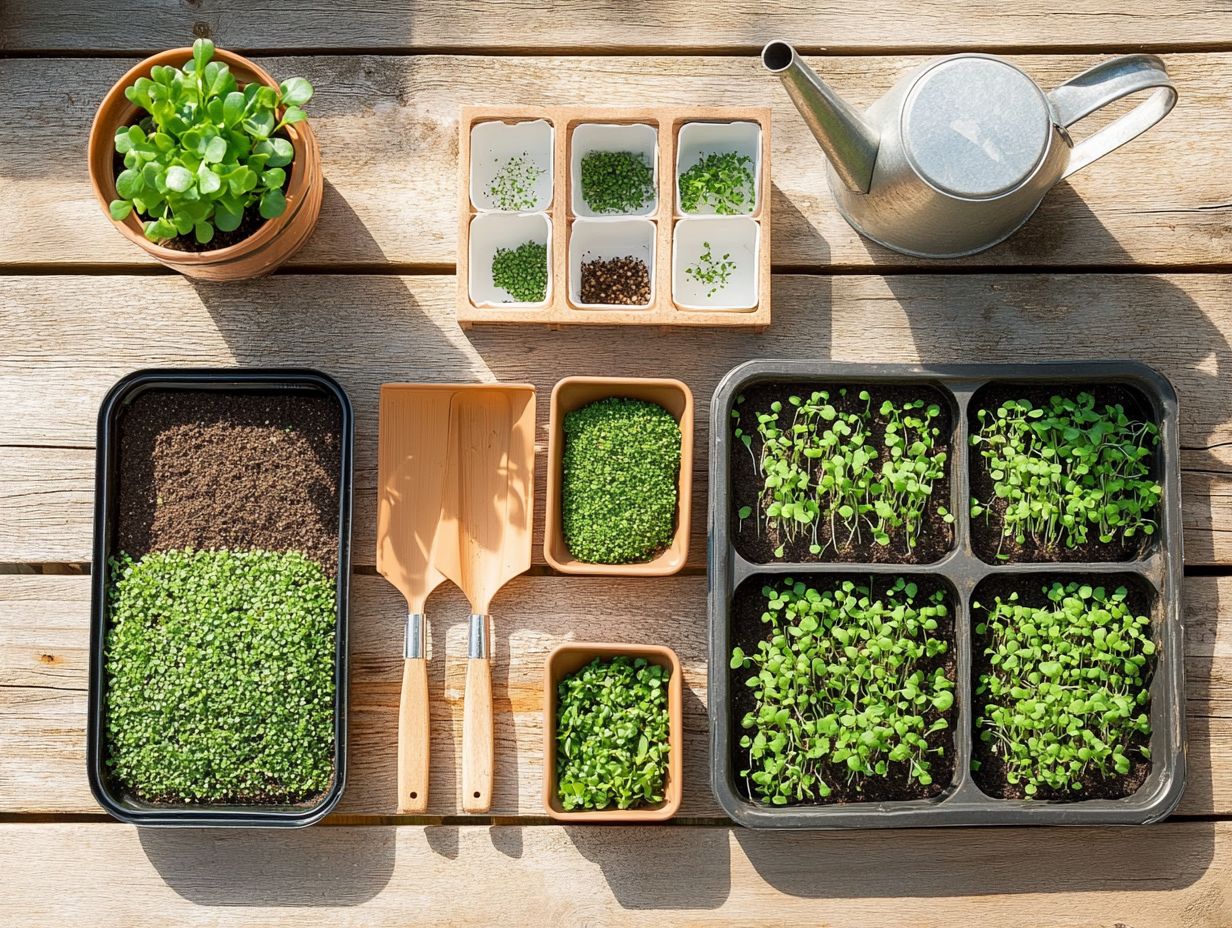
To maximize yield and flavor in microgreens, focus on creating the best growth conditions. Timing your harvest perfectly captures peak taste and nutrition, especially with varieties like Broccoli, Red Russian Kale, and Red Acre Cabbage.
Consider factors like light, temperature, and moisture. These elements create an environment that promotes vigorous growth and enhances rich flavor. Using grow lights that mimic natural sunlight can boost photosynthesis. Additionally, choosing the best containers for microgreen cultivation is essential for maintaining ideal temperatures between 60-75 F for healthy microgreens.
Understand each variety s specific requirements, including type of soil and watering techniques. This knowledge helps you cultivate microgreens that are plentiful and packed with flavor.
Harvesting at the right time just before the first true leaves appear can dramatically elevate both taste and nutrient density. Make every moment of effort truly worthwhile!
Frequently Asked Questions
What are the essential tools for microgreen growing success?
The essential tools for microgreen growing success include grow trays, grow lights, a grow medium, and seeds.
Why do I need grow trays?
Grow trays provide a controlled environment for your microgreens, allowing for proper drainage and aeration.
What type of grow lights should I use for microgreens?
LED grow lights are the best option for growing microgreens. They provide the necessary spectrum of light without producing excess heat.
Do I need a specific type of grow medium for microgreens?
Yes, a high-quality, nutrient-rich grow medium is essential for microgreen growth. Options include coco coir, peat moss, and vermiculite.
Can I use regular seeds for microgreens?
No, regular seeds are not suitable for microgreens. Use seeds specifically labeled for microgreen growing to ensure optimal growth and flavor.
What other tools can help with microgreen growing success?
In addition to the essential tools mentioned, a spray bottle for watering, a fan for air circulation, and a timer for grow lights can all contribute to successful microgreen growth.
Get ready to enjoy delicious, nutrient-packed greens! Explore the joy of growing microgreens and transform your meals!

